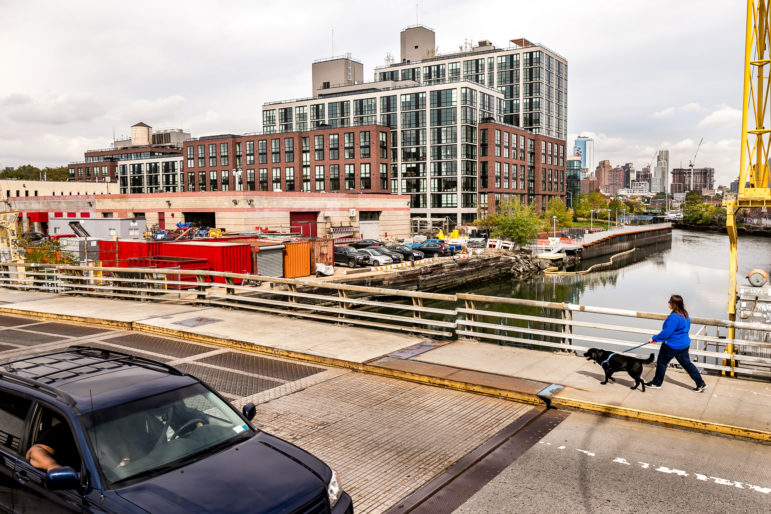Councilmembers Brad Lander and Stephen Levin had both previously expressed support for the plan, but said their ultimate approval depended on the city committing to repairs at the Gowanus and Wyckoff Gardens Houses.

Adi Talwar
The view from the 3rd Street bridge over the Gowanus Canal.Editor’s note: This story has been updated since its original publication to include additional context and details.
New York City officials on Wednesday committed to funding roughly $200 million in renovations at a pair of Gowanus public housing complexes—part of a deal to lock in votes for a neighborhood-level rezoning from two key local lawmakers.
Councilmembers Brad Lander and Stephen Levin had both expressed support for Mayor Bill de Blasio’s plan to add thousands of new apartments to an 82-block section of Gowanus, but said their ultimate approval depended on the city committing to repairs at the Gowanus and Wyckoff Gardens Houses.
Their votes are seen as essential to the fate of the rezoning application, because the full City Council—which is set to vote on the plan during the final steps of the city’s land use review process—traditionally defers to local members on land use issues (though not always).
The agreement now paves the way for a binding vote on the rezoning, which would result in an estimated 8,200 new apartments in the low-slung neighborhood by 2035, including 3,000 units reserved for people making a percentage of area median income under the city’s Mandatory Inclusionary Housing (MIH) program. The proposal has received the backing of the City Planning Commission, Brooklyn Borough President Eric Adams and Brooklyn’s Community Board 6, which made its support contingent on the NYCHA funding. Brooklyn Community Board 2, which represents a small portion of the rezoning area, voted against the plan in June.
Lander, New York City’s comptroller-elect, said Wednesday’s agreement could serve as a model for future rezonings and noted that the Gowanus plan featured the city’s first neighborhood-level racial impact study. A new law mandates that all neighborhood-level land use plans moving forward undergo similar studies.
“After nearly a decade of conversations among neighbors, and in partnership with the Department of City Planning and City Hall, this community has created one of the best models for inclusive growth anywhere, with strong attention to equity and affordability, and mindful of the environmental history and future of this area,” Lander said.
The agreement package also includes the creation of a task force to monitor compliance to the various pledges from the city and private developers, and a commitment to “net-zero” combined sewage overflow (CSO) into the polluted Gowanus Canal as a result of rezoning-related construction, made possible by the city’s new Unified StormWater Rule requirements as well as $174 million in local sewer upgrades, according to Lander’s office.
Critics of the plan, however, as well as the U.S. Environmental Protection Agency (EPA), have disputed the city’s “optimistic” zero-CSO claims. In a letter sent to the Department of City Planning this summer, EPA officials said it found “a number of inconsistencies” in the city’s waste and stormwater calculations for the project.
“For these reasons…EPA cannot assess what the net CSO discharge impacts will be from the proposed rezoning,” the July letter reads. “In addition, EPA cannot assess the extent to which compliance with the proposed 2021 Unified Stormwater Rule will be able to mitigate the additional sanitary flows that will be generated by the proposed redevelopment.”
Supporters say the plan is crucial for fostering diversity and density in whiter, wealthier parts of New York City after years of upzonings in lower-income communities of color, where de Blasio’s MIH strategy did not benefit most existing residents because new homes deemed “affordable” were still too expensive.
The Gowanus rezoning plan, along with another ongoing proposal to upzone SoHo and NoHo, marks the first time that Mayor de Blasio has pursued a neighborhood-level upzoning in a predominantly white community where resident incomes exceed the citywide average. Opponents have challenged that characterization of the demographic makeup of the proposed rezoning area, but a review of overlapping census tracts in the City Planning Department’s “Population FactFinder” database seems to back it up.
Critics of the rezoning have also warned that the plan does not adequately address environmental devastation along the toxic Gowanus Canal, and concentrates much of the planned affordable housing at the heavily polluted Public Place site.
“It would place low-income and homeless families on forever-toxic land that must be monitored for cancer-causing fumes in perpetuity,” the group Voice of Gowanus, which has been fighting the rezoning plan, wrote in a letter to councilmembers ahead of a committee vote Wednesday. “This is where the only 100% affordable development is planned—on this most highly toxic land—and it makes up less than 3% of the entire 200-acre rezone.”
Plan supporters, including Lander, say the city-owned property is undergoing environmental remediation. In September, U.S. Rep. Nydia M. Velázquez joined many of project’s opponents in calling for the city to redo its Draft Environmental Impact Statement (DEIS) for the rezoning, saying the existing DEIS was based on old rainfall data from 2008 and fails to adequately account for the increasing impact of climate change and extreme weather events like Hurricane Ida.
Other critics say the rezoning, which would allow towers up to 30 stories tall near the canal, will permanently change the character of a community home to several two- and three-story homes.
“America needs to preserve its rich past, and to create a freaking gargantuan, ugly, modern building is the last thing we need,” said Robert Maloney, a 71-year-old artist and lifelong Gowanus resident during a June community board hearing.
The Council is expected to vote on the Gowanus rezoning application on Nov. 23.










One thought on “Councilmembers Confirm Support for Gowanus Rezoning After NYC Commits to NYCHA Repairs”
Is Carlos on board?